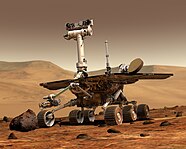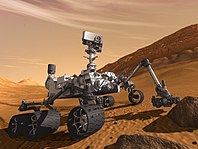Mars Exploration Program
| Part ofa serieson the |
| United States space program |
|---|
  |
Mars Exploration Program(MEP) is a long-term effortto explore the planet Mars,funded and led byNASA.Formed in 1993, MEP has made use of orbitalspacecraft,landers,andMars roversto explore the possibilities oflife on Mars,as well as the planet'sclimateandnatural resources.[1]The program is managed by NASA'sScience Mission DirectoratebyDoug McCuistionof the Planetary Science Division.[2]As a result of 40% cuts to NASA's budget for fiscal year 2013, theMars Program Planning Group(MPPG) was formed to help reformulate the MEP, bringing together leaders of NASA's technology, science, human operations, and science missions.[3][4]
Governance[edit]
First convening in October 1999, the Mars Exploration Program Analysis Group (MEPAG) enables the scientific community to provide input for the planning and prioritizing of the Mars Exploration Program. Mars exploration missions, as do most NASA missions, can be fairly costly. For example, NASA'sCuriosityrover(landed on Mars in Aug 2012) has a budget exceeding $2.5 billion.[5]NASA also has goals of collaborating with theEuropean Space Agency(ESA) in order to conduct a mission involving returning a sample of Mars soil to Earth, which would likely cost at least $5 billion and take ten years to complete.[6]
Objectives[edit]
According to NASA, there are four broad goals of the MEP, all having to do with understanding the potential forlifeon Mars.[7]
- Determine if life ever arose on Mars– In order to understand Mars'habitability potential,it must be determined whether or not there ever waslife on Mars,which begins with assessing the planet's suitability for life. The main strategy regarding the MEP, nicknamed "Follow the Water," is the general idea that where water is present, there is life (at least in instances on Earth). It is likely that if life ever did arise on Mars, there would need to be a supply of water that was present for a substantial amount of time. Therefore, a prominent goal of the MEP is to look for places where water is, was, or could possibly be, such as dried up riverbeds, under the planetary surface, and in Mars' polar ice caps. Aside from water, life also needs sources of energy to survive. The abundance ofsuperoxidesmakes life on the surface of Mars very unlikely, which essentially rules out sunlight as a possible source of energy for life. Therefore, alternative sources of energy must be searched for, such asgeothermalandchemical energy.These sources, which are both used by life forms on Earth, could be used bymicroscopic life formsliving under the Mars' surface. Life on Mars can also be searched for by finding signatures of past and present life orbiosignatures.Relative carbon abundance and the location and forms that it can be found in can inform where and how life may have developed. Also, the presence ofcarbonate minerals,along with the fact thatMars' atmosphereis made up largely ofcarbon dioxide,would tell scientists that water may have been on the planet long enough to foster the development of life.[8]
- Characterize the climate of Mars– Another goal of the MEP is to characterize both the current and pastclimate of Mars,as well as factors that influence climate change on Mars. Currently what is known is that the climate is regulated by seasonal changes of Mars' ice caps, movement of dust by the atmosphere, and the exchange of water vapor between the surface and the atmosphere. To understand these climatic phenomena means helping scientists more effectively model Mars' past climate, which brings a higher degree of understanding of the dynamics of Mars.[9]
- Characterize the geology of Mars– Thegeology of Marsis differentiable from that of Earth by, among other things, its extremely large volcanoes and lack of crust movement. A goal of the MEP is to understand these differences from Earth along with the way that wind, water, volcanoes, tectonics,crateringand other processes have shaped the surface of Mars. Rocks can help scientists describe the sequence of events in Mars' history, tell whether there was an abundance of water on the planet through identifying minerals that are formed only in water, and tell if Mars once had amagnetic field(which would point toward Mars at one point being a dynamic Earth-like planet).[10]
- Prepare for the human exploration of Mars– Ahuman mission to Marspresents a massive engineering challenge. With Mars' surface containing superoxides and lacking amagnetosphereand anozone layerto protect from radiation from the Sun, scientists would have to thoroughly understand as much of Mars' dynamics as possible before any action can be taken toward the goal of putting humans on Mars.[11]
Challenges[edit]
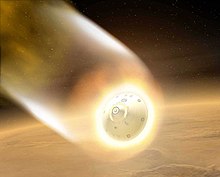
Mars exploration missions have historically had some of the highest failure rates for NASA missions,[12]which can be attributed to the immense engineering challenges of these missions as well as some bad luck, such as the America'sMars Polar Lander.[13]With many of the goals of the MEP involving entry, descent, and landing of spacecraft (EDL) on the surface of Mars, factors like the planet's atmosphere, uneven surface terrain, and high cost of replicating Mars-like environments for testing come into play.[14]
Compared to the Earth, theatmosphere of Marsis about 100 times thinner. As a result, if a landing craft were to descend into Mars' atmosphere, it would decelerate at a much lower altitude, and depending on the object's mass, may not have enough time to reach terminal velocity. In order to deploy super- or subsonic decelerators, velocity must be below a threshold or they will not be effective. Therefore, technologies must be developed so that a landing craft can be decelerated enough to allow adequate time for other necessary landing processes to be carried out before landing.[14]Mars' atmosphere varies significantly over the course of aMars year,which prevents engineers from being able to develop a system for EDL common among all missions. Frequently-occurring dust storms increase lower atmospheric temperature and lessen atmospheric density, which, coupled with the extremely variable elevations on Mars' surface, forces a conservative selection of a landing site in order to allow for sufficient craft deceleration.[14]With Mars EDL sequences only lasting about 5–8 minutes, the associated systems must be unquestionably reliable. Ideally, this would be verified by data obtained by carrying out large-scale tests of various components of the EDL systems on Earth-based testing. However, the costs of reproducing environments in which this data would be relevant in terms of Mars' environment are considerably high, resulting in testing being purely ground-based or simulating results of tests involving technologies derived from past missions.[14]
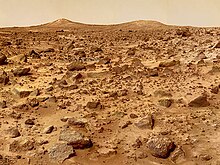
The surface of Mars is extremely uneven, containingrocks,mountainous terrain, and craters. For a landing craft, the ideal landing area would be flat and debris-free. Since this terrain is almost impossible to find on Mars, landing gear must be very stable and have enough ground clearance to prevent problems with tipping over and instability upon landing. In addition, the deceleration systems of these landers would need to include thrusters that are pointed at the ground. These thrusters must be designed so that they only need to be active for an extremely short amount of time; if they are active and pointed at rocky ground for more than a few milliseconds, they start to dig trenches, launch small rocks up into the landing gear, and cause destabilizing backpressure to be forced upon the lander.[14]
Finding an adequate landing site means being able to estimate rock size from orbit. The technology to accurately determine rock size under 0.5 meters in diameter from orbit has not yet been developed, so instead rock size distribution is inferred from its relationship to thermal inertia, based on thermal response of the landing site measured by satellites currently orbiting Mars. TheMars Reconnaissance Orbiteralso helps this cause in the sense that its cameras can see rocks larger than 0.5 m in diameter.[14]Along with the possibility of the lander tipping over on sloped surfaces, large topographical features like hills, mesas, craters and trenches pose the problem of interference with ground sensors. Radar and Doppler radar can falsely measure altitude during descent and the algorithms that target the touchdown point of the lander can be "tricked" into releasing the lander too early or late if the craft passes over mesas or trenches while descending.[14]
History[edit]
Background[edit]
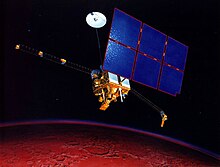
While it was observed in ancient times by theBabylonians,Egyptians,Greeks,and others, it was not until the invention of thetelescopein the 17th century that Mars was studied in depth.[15]The first attempt at sending a probe to the surface of Mars, nicknamed"Marsnik 1,"was by theUSSRin 1960. The probe failed to reachEarthorbit, and the mission was ultimately unsuccessful. Failure to complete mission objectives has been common in missions designed to explore Mars; roughly two-thirds of all spacecraft destined for Mars have failed before any observation could begin.[12]The Mars Exploration Program itself was formed officially in the wake of the failedMars Observerin September 1992,[1]which had been NASA's first Mars mission since theViking 1andViking 2projects in 1975. The spacecraft, which was based on a modified Earth-orbiting commercial communicationssatellite(i.e., SES'sAstra 1Asatellite), carried a payload of instruments designed to study the geology, geophysics, and climate of Mars from orbit. The mission ended in August 1993 when communications were lost three days before the spacecraft had been scheduled to enterorbit.[16]
2000s[edit]
In the 2000s, NASA established theMars Scout Programas a campaign under the Mars Exploration Program to send a series of small, low-cost robotic missions toMars,competitively selected from innovative proposals by the scientific community with a budget cap of US$485 million. The firstrobotic spacecraftin this program wasPhoenix,which utilized alanderoriginally manufactured for the canceledMars Surveyor 2001mission.Phoenixwas one of four finalists selected out of 25 proposals.[17]The four finalists were Phoenix, MARVEL,SCIM(Sample Collection for Investigation of Mars), and theARES( "Aerial Regional-scale Environmental Survey" ) Mars airplane.[17]SCIM was a sample return mission that would have used a free-return trajectory and aerogel to capture Mars dust and return it to Earth[17](see also: theStardustmission). MARVEL was an orbiter that would have searched for volcanism as well as analyzed various components of the Mars atmosphere.[17]The name is an acronym forMars Volcanic Emission and Life Scout,and it was intended to detect gases from life if it was there.[17]ARES was an aircraft concept for Mars to study the lower atmosphere and surface.[17]On September 15, 2008, NASA announced that it had selectedMAVENfor the second mission.[18][19][20]This mission was budgeted at no more than US$475 million.[21]After only two selections, the NASA Science Directorate announced in 2010 that Mars Scout would be incorporated into theDiscovery program,which was re-scoped to allow Mars missions to be proposed.[22]InSight,a Mars seismology and geology mission, was ultimately chosen as the twelfth Discovery program mission.
| Proposed Mars Scout program missions (2003–10)[23][24] | |
|---|---|
| Mission Name | Description |
| The Great Escape (TGE) | The mission would have directly determined the basic processes in Martian atmospheric evolution by measuring the structure and dynamics of the upper atmosphere. In addition, potentially biogenic atmospheric constituents such asmethanewould have been measured. The principal investigator is Alan Stern, Southwest Research Institute, Boulder, Colorado. Southwest Research Institute, San Antonio, would have provided project management.[25] |
| Artemis | This mission would launch up to four saucer-shaped landers, two feet (0.61m) in diameter, from a "mother ship" orbiting Mars. Each would parachute onto the surface, analyzing the soil and atmosphere. Two of the four landers would be targeted at the polar regions. |
| ARES | This mission concept proposed to send an unmanned airplane into the Martian atmosphere to observe the planet.[26][27] |
| Chronos | This mission would consist of a probe designed to melt through a polar ice cap using heated jets. It would travel up to 100 yards (91m) below the surface, analyzing the melted water to determine the climatic history of Mars.[28] |
| KittyHawk | This mission would create three or four winged gliders with approximately six-foot (1.83m) wingspans and would explore theValles Marineriscanyon system. The gliders would carry infrared spectrometers and cameras. |
| MOO | With infrared telescopes on Earth and a spectrometer on theMars Express Orbiter,methanewas discovered in the Martian atmosphere. The presence of methane on Mars is very intriguing, since as an unstable gas it indicates that there must be an active source of the gas on the planet. The latest research suggests that the methane destruction lifetime is as long ~4 Earth years and as short as ~0.6 Earth years.[29]In either case, the destruction lifetime for methane is much shorter than the timescale (~350 years) estimated for photochemical (UVradiation) destruction.[29]The Mars Organics Observer would use an orbiter to characterize the Martian methane: where it is being emitted, how much is being emitted and how often it is being emitted. |
| The Naiades | Named fornymphsof springs, lakes, and rivers from Greek mythology, this mission would send two landers to a region which likely holds groundwater. The landers would search for the groundwater using low-frequency electromagnetics and other instruments. |
| SCIM | A sample return mission that would briefly pass into the Martian atmosphere to scoop up about 1000 dust grains and a few liters of air without slowing from escape velocity. |
| THOR | Similar to NASA'sDeep Impact,this mission would impact two copper spheres into Mars' surface to create craters in a region known to have water ice, and maybe liquid water, a few meters under the surface. An accompanying orbiter would analyze the craters from orbit. Although this mission was not selected, ice was later observed in fresh natural impacts.[30] |
| Urey | This mission calls for a lander/rover pair designed to analyze the ages of rocks. It would be targeted for theCerberus Highlandsregion, and would look for specific minerals to help scientists compare the cratering of Mars with that of the Moon. |
| MARVEL | Orbiter with spectrometers would look for volcanic emissions and life |
| CryoScout | Melt probe for ice caps |
| Pascal | 24 mini weather stations. Also proposed in theDiscovery Program.[31] |
| MEO | Mars Environmental Orbiter—study atmosphere and hydrology |
| MACO | Mars Atmospheric Constellation Observatory—a network ofmicrosatellitesstudy the atmosphere |
| MSR | Mars Scout Radar—Synthetic Aperture Radar (SAR) to study sub-surface |
2010s[edit]
A significant budget cut of US$300 million to NASA's planetary science division occurred in FY2013, which prompted the cancellation of the agency's participation in ESA'sExoMarsprogram, as well as a reevaluation of the Mars Exploration Program as a whole.[32][33][34]In February 2012, the Mars Program Planning Group (MPPG) was convened in Washington, D.C. to discuss candidate mission concepts for the 2018 or 2020 launch window,[35][34]in an initiative known as Mars Next Generation.[35][36][37]The purpose of the MPPG was to develop foundations for a program-level architecture for robotic exploration of Mars that is consistent with theObama administration's challenge of sending humans to Mars orbit in the decade of the 2030s,[34]yet remain responsive to the primary scientific goals of the 2011 NRC Decadal Survey for Planetary Science.[38]The MPPG used non-consensus, individual inputs of both NASA civil servant and contractor employees, with resulting decisions being the exclusive responsibility of NASA.
The immediate focus of the MPPG was on the collection of multiple mission concept options for the 2018 and 2020 Mars launch window.[34]At a budget envelope of $700 millionUSD,including alaunch vehicle,it was presumed that the mission would be limited to anorbiter.[36][39]Near-term ideas were taken into consideration for early mission planning in the 2018-2024 timeframe, while mid- to longer-term ideas informed program-level architecture planning for 2026 and beyond.[40]Strategies explored for such a mission included asample-return missionwhere soil samples are placed in Mars orbit in the late 2020s or early 2030s, an in-situ soil analysis, and a study of Mars' surface and deep interior preceding a sample-return mission and/or crewed mission.[34]Concept missions that were studied that fit the budget requirement of US$700 million to US$800 million included theNext Mars Orbiter(NeMO) to replace aging satellites' telecommunication services, and a stationary lander to investigate and select samples suitable for a later return to Earth.[34]Prior to the findings of the MPPG, theHouse Appropriations Committee'sCommerce-Justice-Science subcommittee approved a budget in April 2012 that reinstated US$150 million to the Planetary Science budget, with a caveat that a sample-return mission be mandated.[32]The MPPG's final report was drafted in August 2012 and published in September.[41][42][43]Ultimately endorsing a sample-return mission, the recommendation influenced NASA's FY2014 budget process.[44]
Missions[edit]
List[edit]
| Mission | Patch | Vehicle | Launch | Orbital insertion/Landing Date | Launch vehicle[a] | Status | Duration |
|---|---|---|---|---|---|---|---|
| Mars Global Surveyor | Mars Global Surveyor | November 7, 1996, 17:00 UTC | September 11, 1997 01:17 UTC | Delta II 7925 | Completed | 3,647 days | |
| Mars Surveyor '98 | Mars Climate Orbiter | December 11, 1998, 18:45 UTC | September 23, 1999 09:00 UTC(failed) | Delta II 7425 | Failure | 286 days | |
| Mars Polar Lander | January 3, 1999, 20:21 UTC | December 3, 1999 20:15 UTC(failed) | Delta II 7425 | Failure | 334 days | ||
| 2001 Mars Odyssey | Mars Odyssey | April 7, 2001, 15:02 UTC | October 24, 2001 12:21 UTC | Delta II 7925-9.5 | Operational | 8,502 days | |
| Mars Exploration Rover | Spirit | June 10, 2003, 17:58 UTC | January 4, 2004 04:35 UTC | Delta II 7925-9.5 | Completed | 2,695 days | |
| Opportunity | July 7, 2003, 03:18 UTC | January 25, 2004 05:05 UTC | Delta II 7925H-9.5 | Completed | 5,498 days | ||
| Mars Reconnaissance Orbiter | Mars Reconnaissance Orbiter | August 12, 2005, 11:43 UTC | March 10, 2006 21:24 UTC | Atlas V 401(AV-007) | Operational | 6,911 days | |
| Phoenix[b] | Phoenix | August 4, 2007 09:26 UTC | May 25, 2008 23:53 UTC | Delta II 7925 | Completed | 457 days | |
| Mars Science Laboratory | Curiosity | November 26, 2011, 15:02 UTC | August 6, 2012 05:17 UTC | Atlas V 541 (AV-028) | Operational | 4,251 days | |
| MAVEN[b] | MAVEN | November 18, 2013, 18:28 UTC | September 22, 2014 02:24 UTC | Atlas V 401 (AV-038) | Operational | 3,894 days | |
| InSight | InSight | May 5, 2018, 11:05 UTC | November 26, 2018 19:52 UTC | Atlas V 401 | Completed | 2,060 days | |
| Mars 2020 | Perseverance | July 30, 2020, 11:50 UTC | February 18, 2021 20:55 UTC | Atlas V 541 (AV-088) | Operational | 1,245 days | |
| Ingenuity | Completed | 1,026 | |||||
| Mars Exploration Ice Mapper | Mars Exploration Ice Mapper | 2026 | 2027 | TBD | Proposed | N/A |
Timeline[edit]

See also[edit]
References[edit]
Notes
Citations
- ^abShirley, Donna."Mars Exploration Program Strategy: 1995–2020"(PDF).American Institute of Aeronautics and Astronautics.Archived fromthe original(PDF)on May 11, 2013.RetrievedOctober 18,2012.
- ^McCuistion, Doug."Doug McCuistion, Director, NASA Mars Exploration Program".NASA.Archived fromthe originalon October 19, 2015.RetrievedOctober 18,2012.
- ^Hubbard, G. Scott (August 28, 2012)."A Next Decade Mars Program".The Huffington Post.RetrievedOctober 18,2012.
- ^Garvin, James."About the Mars Program Planning Group".NASA.RetrievedOctober 18,2012.
- ^Leone, Dan."Mars Science Lab Needs $44M More To Fly, NASA Audit Finds".Space News.Archived fromthe originalon May 26, 2012.RetrievedOctober 24,2012.
- ^de Selding, Peter."Study: Mars Sample Return Would Take 10 Years, Cost $5 Billion-Plus".Space News.RetrievedOctober 24,2012.[dead link]
- ^"The Mars Exploration Program's Science Theme".Mars Exploration Program.NASA. Archived fromthe originalon August 6, 2011.RetrievedOctober 18,2012.
- ^"Goal 1: Determine if Life Ever Arose On Mars".Mars Exploration Program.NASA.RetrievedOctober 18,2012.
- ^"Goal 2: Characterize the Climate of Mars".Mars Exploration Program.NASA.RetrievedOctober 18,2012.
- ^"Goal 3: Characterize the Geology of Mars".Mars Exploration Program.NASA.RetrievedOctober 18,2012.
- ^"Goal 4: Prepare for the Human Exploration of Mars".Mars Exploration program.NASA.RetrievedOctober 18,2012.
- ^ab"A Chronology of Mars Exploration".NASA History Program Office.RetrievedOctober 18,2012.
- ^O'Neill, Ian (March 22, 2008)."The Mars Curse".Universe Today.RetrievedOctober 18,2012.
- ^abcdefgBraun, Robert (2007)."Mars Exploration Entry, Descent and Landing Challenges"(PDF).Journal of Spacecraft and Rockets.44(2): 310–323.Bibcode:2007JSpRo..44..310B.CiteSeerX10.1.1.463.8773.doi:10.2514/1.25116.Archived fromthe original(PDF)on May 26, 2010.RetrievedOctober 18,2012.
- ^"Mars Exploration History".Mars Exploration Program.NASA.RetrievedOctober 18,2012.
- ^"Mars Observer".Mars Exploration Program.NASA.RetrievedOctober 18,2012.
- ^abcdef"Spaceflight Now | Breaking News | NASA selects four Mars Scout mission concepts for study".spaceflightnow.RetrievedMay 31,2023.
- ^"NASA Selects 'MAVEN' Mission to Study Mars Atmosphere".NASA. September 15, 2008.
- ^NASA Selects Proposals for Future Mars Missions and Studies
- ^"NASA Delays Mars Scout Mission to 2013".NASA. December 21, 2007.
- ^JPL.NASA.GOV: News Release
- ^NASA's Scout Program Discontinued.
- ^Scout Missions - Mars News
- ^NASA SELECTS FIRST MARS SCOUT CONCEPTS FOR FURTHER STUDY (2001)
- ^Southwest Research Institute proposal for Mars Scout orbiter mission selected for study by NASA
- ^"ARES - A Proposed Mars Scout Mission".NASA. January 17, 2007. Archived fromthe originalon March 28, 2010.
- ^ARES Mars Aircraftyoutube video of model and test flight
- ^CHRONOS - A Journey Through Martian History
- ^abMumma, Michael J. (February 20, 2009)."Strong Release of Methane on Mars in Northern Summer 2003"(PDF).Science.323(5917): 1041–1045.Bibcode:2009Sci...323.1041M.doi:10.1126/science.1165243.PMID19150811.S2CID25083438.
- ^Neil F. Comins -Discovering the Essential Universe(2012) - Page 148
- ^R. Haberle, et al. - The Pascal Discovery Mission: A Mars Climate Network Mission (2000)
- ^abBrown, Adrian."MSL and the NASA Mars Exploration Program: Where we've been, where we're going".The Space Review.RetrievedOctober 24,2012.
- ^Morning Jr., Frank (February 14, 2012)."NASA Units Hope For 2018 Robotic Mars Mission".Aviation Week.RetrievedFebruary 27,2012.
- ^abcdef"About the Mars Program Planning Group".RetrievedJuly 20,2012.
- ^abLeone, Dan (February 24, 2012)."NASA Raids Outer Planets Budget To Fund Fast Start on Mars Reboot".Space News.Archived fromthe originalon February 2, 2013.RetrievedFebruary 25,2012.
- ^abEric Hand (February 28, 2012)."Beset by budget cuts, US Mars scientists look to possible 2018 mission".Nature.RetrievedFebruary 28,2012.
- ^Kate Taylor (April 16, 2012)."NASA calls for ideas for future Mars missions".TG Daily.RetrievedApril 16,2012.
- ^"Science Strategy | NASA Solar System Exploration".Solarsystem.nasa.gov.Archived fromthe originalon July 21, 2011.RetrievedFebruary 23,2016.
- ^Stephen Clark (September 27, 2012)."Sample return remains focus of NASA's Mars program".Space Flight Now.RetrievedSeptember 28,2012.
- ^"Concepts for Future Mars Missions".Astrobiology Magazine.May 29, 2012. Archived fromthe originalon March 9, 2021.RetrievedFebruary 23,2016.
- ^"NASA - Mars Program Planning Group Milestones".Nasa.gov.RetrievedFebruary 23,2016.
- ^Dan Leone (October 3, 2012)."Mars Planning Group Endorses Sample Return".Space News.RetrievedJune 4,2023.
- ^"Summary of the Final Report"(PDF).Nasa.gov.September 25, 2012.RetrievedFebruary 23,2016.
- ^"NRC Committee on Astrobiology and Planetary Science (CAP+S)"(PDF).Nasa.gov.May 23, 2012.RetrievedFebruary 23,2016.
External links[edit]
- Mars Exploration Programat theJet Propulsion Laboratory
- Mars Exploration Program Analysis Group (MEPAG)at the Jet Propulsion Laboratory

